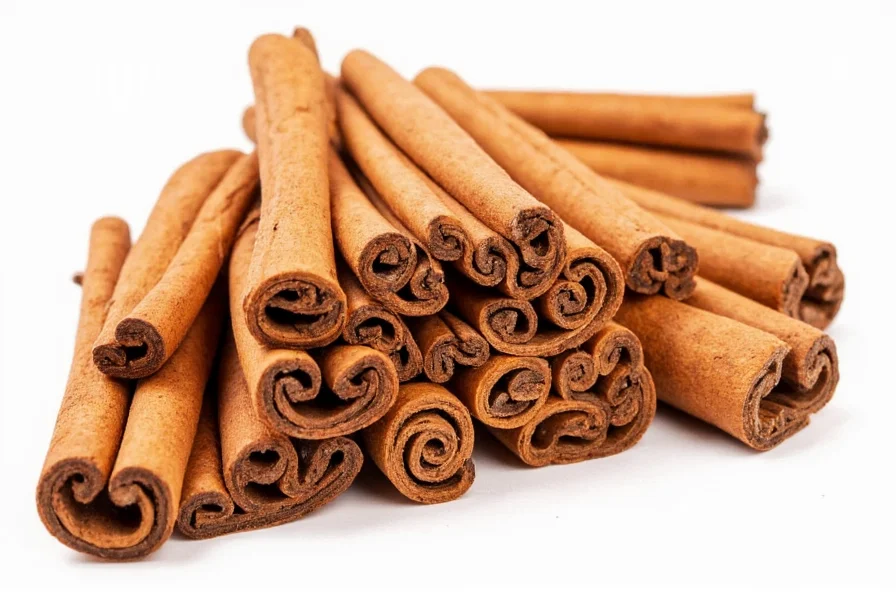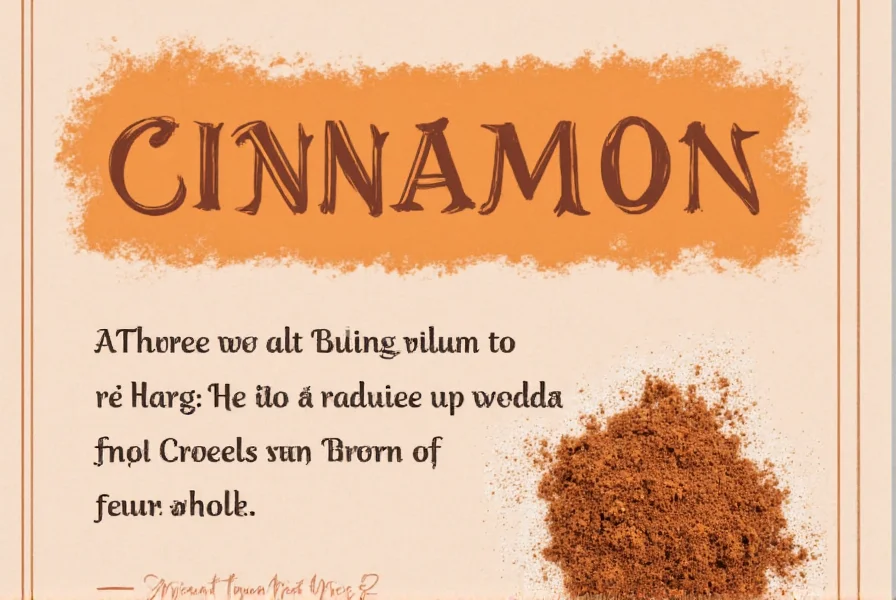Table of Contents
Vietnamese cinnamon (Saigon cinnamon) is significantly stronger, spicier, and contains up to 12% coumarin - a compound that can harm the liver in high doses. Cassia cinnamon (commonly sold as "regular cinnamon" in US supermarkets) is milder but still contains high coumarin levels. Ceylon cinnamon (true cinnamon) is the safest for regular consumption. This guide explains the critical differences in flavor, health implications, and best uses.
What is Vietnamese Cinnamon?
Vietnamese cinnamon (Cinnamomum loureiroi), also called Saigon cinnamon, is a high-oil variety of Cassia cinnamon grown primarily in central Vietnam. It contains 25-30% cinnamaldehyde (the compound responsible for cinnamon's flavor) and 6-12% coumarin by weight - among the highest levels of any cinnamon variety. Its bark is thick, dark reddish-brown, and has a rigid texture. The aroma is intensely spicy with notes of clove and licorice.
Due to its high coumarin content, the European Food Safety Authority (EFSA) recommends limiting daily intake to 0.1 mg per kg of body weight. For a 70kg adult, this equals about 1/2 teaspoon of Vietnamese cinnamon per day. It's best used sparingly in bold dishes like Vietnamese pho, spiced coffee, or mulled wine where its intense flavor can shine without overuse.
What is Cassia Cinnamon?
Cassia cinnamon (Cinnamomum cassia) is the most common "regular cinnamon" found in US grocery stores. It contains 5-10% coumarin (still high but less than Vietnamese cinnamon) and 2-5% cinnamaldehyde. Its bark is thinner and lighter brown than Vietnamese cinnamon, with a sweet, warm flavor that's less pungent. Cassia is often labeled simply as "cinnamon" in the US, while "Ceylon" or "true cinnamon" refers to the safer Ceylon variety.
While Cassia is versatile for everyday baking, its coumarin content makes it unsuitable for daily consumption in large quantities. The FDA warns that regular high intake can cause liver damage. For most home cooking, Cassia is acceptable when used in moderation (1-2 teaspoons per day for adults), but Ceylon cinnamon is recommended for regular use.
Vietnamese vs Cassia: Core Differences
| Feature | Vietnamese Cinnamon | Cassia Cinnamon | Ceylon Cinnamon |
|---|---|---|---|
| Scientific Name | Cinnamomum loureiroi | Cinnamomum cassia | Cinnamomum verum |
| Coumarin Content | 6-12% by weight | 5-10% by weight | <0.02% by weight |
| Cinnamaldehyde | 25-30% | 2-5% | 50-60% |
| Flavor Profile | Intensely spicy, clove-like | Sweet, warm, moderate | Delicate, floral, subtle |
| Color | Darkest reddish-brown | Moderate brown | Light tan |
| Bark Texture | Thick, rigid, single curl | Medium thickness, multiple layers | Thin, brittle, paper-like |
| Best Uses | Spicy dishes, coffee, mulled wine | Everyday baking, stews, rubs | Desserts, delicate sauces, daily use |
| Health Considerations | High risk for liver damage with regular use | Use in moderation (1-2 tsp/day) | Safest for daily consumption |

Practical Tips for Using Both Cinnamons
- Use Vietnamese cinnamon sparingly: Substitute 1/2 teaspoon Vietnamese for 1 teaspoon Cassia in recipes. Ideal for dishes where strong flavor is desired (e.g., Vietnamese pho, chai tea).
- For everyday baking: Use Cassia cinnamon but limit to 1-2 teaspoons per day. Avoid using it in large quantities for daily consumption.
- Health-conscious choice: Choose Ceylon cinnamon for daily use. It has negligible coumarin and is safe for regular consumption.
- Storage: Keep all cinnamon in airtight containers away from light. Vietnamese cinnamon loses potency faster than Cassia due to higher oil content.
- Testing quality: Rub a small piece between your fingers. Vietnamese cinnamon releases strong, spicy aroma immediately. Cassia has a sweeter, more rounded scent.
Buying Guide: How to Choose the Right Cinnamon
For Vietnamese Cinnamon:
- Look for "Saigon cinnamon" or "Vietnamese cinnamon" on labels - avoid generic "cinnamon" which usually means Cassia
- Check for dark reddish-brown color and thick, rigid sticks
- Reputable brands: McCormick Gourmet, Penzeys, and specialty Asian grocery stores
- Price: Typically $8-$15 per 4oz container (more expensive due to limited production)
For Cassia Cinnamon:
- Most "regular" cinnamon in US supermarkets is Cassia - check labels for "Cinnamomum cassia"
- Whole sticks should have multiple layers and moderate brown color
- Look for "ground cinnamon" with fine texture and strong aroma
- Price: $3-$8 per 4oz container (most affordable option)
For Ceylon Cinnamon (Safest Option):
- Must be labeled "Ceylon cinnamon" or "true cinnamon" - never sold as "regular cinnamon"
- Look for thin, brittle sticks that crumble easily and light tan color
- Reputable brands: Simply Organic, Frontier Co-op, and specialty health stores
- Price: $10-$20 per 4oz container (most expensive but safest for daily use)
Frequently Asked Questions
Is Vietnamese cinnamon stronger than Cassia cinnamon?
Yes, Vietnamese cinnamon is significantly stronger than Cassia. It contains 25-30% cinnamaldehyde (vs 2-5% in Cassia) and has a more intense, spicy flavor profile. Use only half the amount when substituting Vietnamese for Cassia in recipes.
Which cinnamon has the highest coumarin content?
Vietnamese cinnamon has the highest coumarin content (6-12% by weight), followed by Cassia (5-10%). Ceylon cinnamon contains less than 0.02% coumarin. The European Food Safety Authority (EFSA) recommends limiting daily coumarin intake to 0.1 mg per kg of body weight to avoid liver damage.
Can I use Vietnamese cinnamon for baking?
Yes, but use sparingly. Due to its intense flavor and high coumarin content, substitute only 1/2 teaspoon Vietnamese cinnamon for every 1 teaspoon of Cassia in baking recipes. It's best for bold dishes like spiced coffee or mulled wine rather than delicate desserts.
Why is Ceylon cinnamon called "true cinnamon"?
Ceylon cinnamon (Cinnamomum verum) is the original cinnamon species native to Sri Lanka. "True cinnamon" refers to its historical use as the original cinnamon traded globally. All other varieties (Vietnamese, Cassia) are different species that became more common due to lower production costs.
Is Cassia cinnamon the same as "regular cinnamon"?
Yes, in the US and most Western countries, "regular cinnamon" sold in grocery stores is almost always Cassia cinnamon (Cinnamomum cassia). Only specialty stores or labeled "Ceylon" products contain true cinnamon. Always check the botanical name on labels to confirm.
Which cinnamon is safest for daily consumption?
Ceylon cinnamon is the safest for daily consumption due to its negligible coumarin content (less than 0.02%). Vietnamese and Cassia cinnamon contain high coumarin levels that can cause liver damage with regular use. The FDA recommends limiting Cassia to 1-2 teaspoons per day for adults.
How can I tell Vietnamese cinnamon apart from Cassia?
Vietnamese cinnamon sticks are darker reddish-brown, thicker, and more rigid than Cassia. When rubbed, Vietnamese releases a stronger, spicier aroma. Cassia sticks have multiple thin layers and a more uniform brown color. The safest method is to check labels for "Saigon cinnamon" or "Cinnamomum loureiroi" for Vietnamese, and "Cinnamomum cassia" for Cassia.
Conclusion
The critical difference between Vietnamese and Cassia cinnamon lies in their coumarin content and flavor intensity. Vietnamese cinnamon offers bold, spicy notes but carries significant liver health risks with regular use. Cassia is more common and affordable but still requires moderation. For daily consumption, Ceylon cinnamon is the only safe choice due to its negligible coumarin levels.
When shopping, always check labels for botanical names: Cinnamomum loureiroi for Vietnamese, Cinnamomum cassia for Cassia, and Cinnamomum verum for Ceylon. Remember: what's labeled "regular cinnamon" in US stores is almost always Cassia - not the safer Ceylon variety.

For optimal health and flavor, choose Ceylon cinnamon for daily use, reserve Vietnamese for special bold dishes, and use Cassia in moderation. Always prioritize labeled botanical names over generic "cinnamon" terms when purchasing.










 浙公网安备
33010002000092号
浙公网安备
33010002000092号 浙B2-20120091-4
浙B2-20120091-4